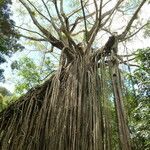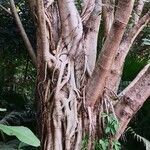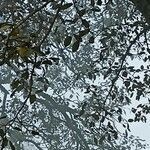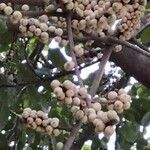Trees, epiphytic when young, with buttress or prop roots, deciduous or semideciduous. Stipules lanceolate-ovate, to 1 cm, apex acute. Petiole 2-5 cm; leaf blade obovate, narrowly lanceolate, ovate-lanceolate, or elliptic-ovate, 10-20 × 4-7 cm, thinly leathery to thickly papery, not shiny when dry, base bluntly rounded, cuneate, or cordate, margin entire, apex acuminate to shortly acuminate; basal lateral veins short, secondary veins (5-)7-10(-11) on each side of midvein, and abaxially prominent, reticulate veins ± conspicuous. Figs axillary on leafy branchlets, paired or solitary or in clusters on leafless older branchlets, purple red when mature, globose, 7-12 mm in diam., with conspicuous interfloral bristles, sessile or pedunculate; involucral bracts small. Male, gall, and female flowers within same fig. Male flowers: few, near apical pore, sessile; calyx lobes 4 or 5, lanceolate; stamen 1; filament short; anther broadly ovoid. Gall flowers: pedicellate; calyx lobes 3 or 4; style lateral, shorter than ovary. Female flowers: similar to gall flowers; style longer than ovary. Achenes wrinkled on surface. Fl. Apr-Aug.
A fig. It is a tall and often very large tree. It can lose all or some of its leaves during the year. It grows 15-30 m high and spreads 15-40 m across. It is a widely spreading plant often with a rounded crown. It can have both strangling roots and aerial roots. The trunk is short and very thick. It has irregular flanges on it and buttresses. It can have a mass of prop roots. The bark is dark grey to brown. Young shoots are bright green. The leafy growth at the base of the leaf is sword shaped and 10 cm long. The leaf stalk is 2-5 cm long. The leaves are 6-15-20 cm long and 4-6 cm wide. They are oval or sword shaped and thin but leathery. They are dark green above but with pale veins and leaves are dull underneath. The male and female flowers occur in the one fig. The male flowers are few and near the opening. The fruit or figs are about 1 cm across. They are round and greenish white to brown with white or red dots. They are wrinkled on the surface. Varieties with different leaf shapes have been described.
Deciduous banyan with few aerial roots or strangler to over 30 m high. Leaves: lamina ovate to elliptic, (5–) 8–19 cm long, 3.5–10 cm wide, subcordate, truncate to cuneate at base, sometimes sinuous margin, bluntly acuminate with tip less than 1 cm long, glabrous; lateral veins 7–12 pairs with 1–4 zig-zag intercostals; petiole 2.5–7 (–10) cm long; stipules to 1.5 cm long, finely puberulous. Figs paired, sessile or pedunculate, globular to depressed-globular or pyriform, c. 0.7–2 cm diam., ripening purple to black; ostiole 1–2 mm diam., enclosed by 3 flat apical bracts in a disc; basal bracts 3, ovate, 1.5–3 mm long, 2–4 mm wide. Male flowers ostiolar, sessile; tepals 2 or 3. Female and gall flowers sessile; tepals free, 3 or 4; ovary sessile or stalked. See also Wheeler (1992: 83), Cooper & Cooper (2004: 328), Dixon (2011: 19), Zich et al. (2020).










